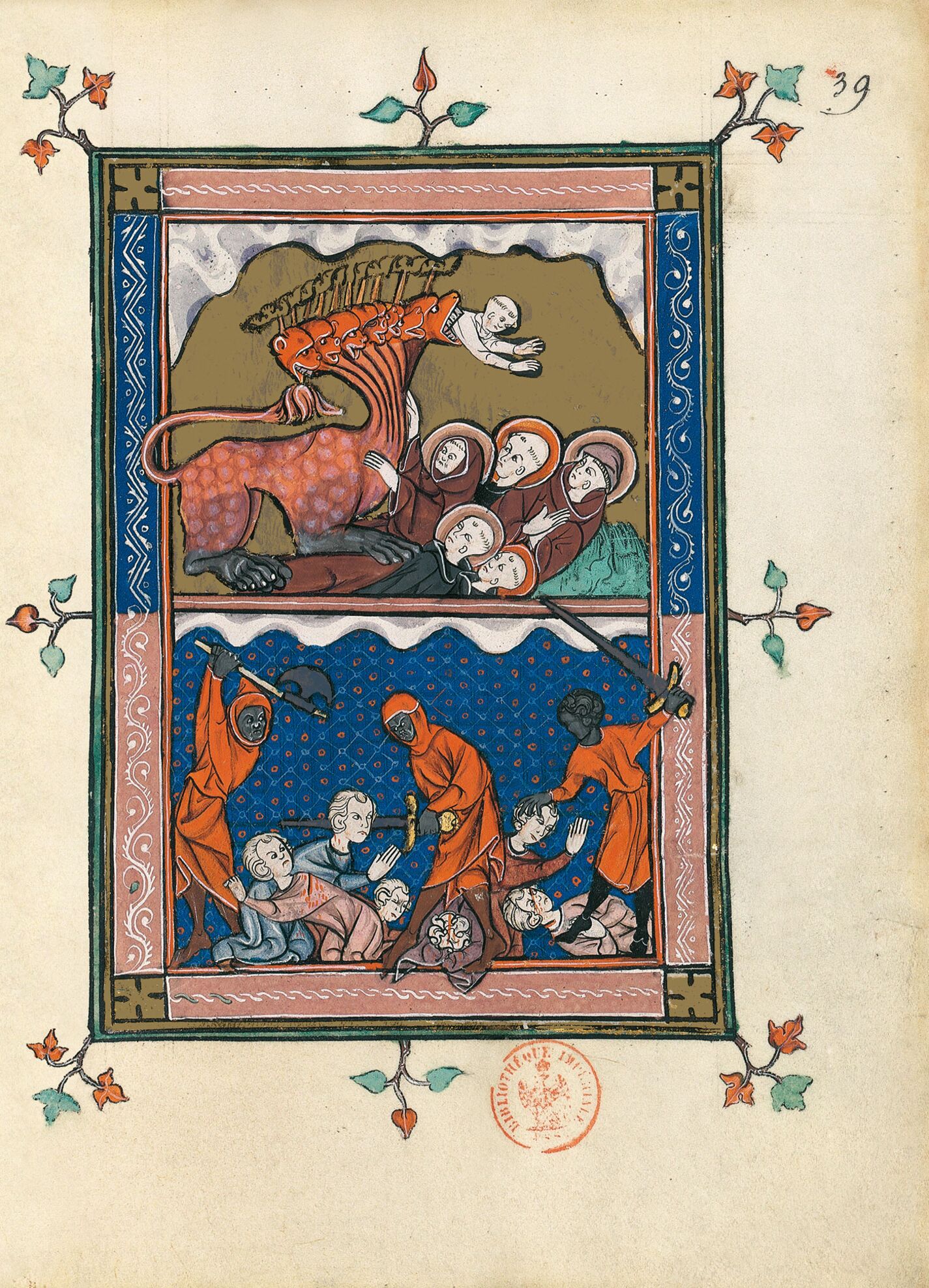John stops writing (f. 38v) to watch the actions of the Beast he saw emerge from the sea. Here, the Beast is depicted full length (f. 39) with the legs of a bear and a lion’s mouth, a dappled, fiery orange coat supposedly like a panther’s. Its seven heads have ten horns with diadems. After the Dragon transfers his strength, the Beast also receives the power to utter blasphemies against God and his abode and those who are in heaven, and to vanquish the saints. In the upper register, the clouds have moved away to reveal a golden sky as bright as the Beast’s crowns. With its invincible force, it tramples upon the saints shown as five haloed monks: three lesser monks dressed in brown and two Benedictine monks in black. Emerging from the monster’s mouth is a tonsured man in a white tunic waving his arms at the saints struck down. In the light of the gloss, it must be understood that his apparent whiteness, clerical appearance and the defiant gesture made at the religious make this impostor a symbol of blasphemy and heresy. Depicted in the lower register of the composition is John’s warning that those who kill by the sword will die by the sword. In the shade of a blue ground, the forces of darkness lay into his followers. Three executioners with grimacing, grey faces dressed in the Beast’s colours are busy at work. Two armed with swords and a third with a battle axe mercilessly behead and set about the violent, ungodly ones.
Marie-Thérèse Gousset and Marianne Besseyre
Illuminated Manuscripts Research Center, Bibliothèque nationale de France
Fragment of the Apocalypse of 1313 commentary volume

John stops writing (f. 38v) to watch the actions of the Beast he saw emerge from the sea. Here, the Beast is depicted full length (f. 39) with the legs of a bear and a lion’s mouth, a dappled, fiery orange coat supposedly like a panther’s. Its seven heads have ten horns with diadems. After the Dragon transfers his strength, the Beast also receives the power to utter blasphemies against God and his abode and those who are in heaven, and to vanquish the saints. In the upper register, the clouds have moved away to reveal a golden sky as bright as the Beast’s crowns. With its invincible force, it tramples upon the saints shown as five haloed monks: three lesser monks dressed in brown and two Benedictine monks in black. Emerging from the monster’s mouth is a tonsured man in a white tunic waving his arms at the saints struck down. In the light of the gloss, it must be understood that his apparent whiteness, clerical appearance and the defiant gesture made at the religious make this impostor a symbol of blasphemy and heresy. Depicted in the lower register of the composition is John’s warning that those who kill by the sword will die by the sword. In the shade of a blue ground, the forces of darkness lay into his followers. Three executioners with grimacing, grey faces dressed in the Beast’s colours are busy at work. Two armed with swords and a third with a battle axe mercilessly behead and set about the violent, ungodly ones.
Marie-Thérèse Gousset and Marianne Besseyre
Illuminated Manuscripts Research Center, Bibliothèque nationale de France
Fragment of the Apocalypse of 1313 commentary volume